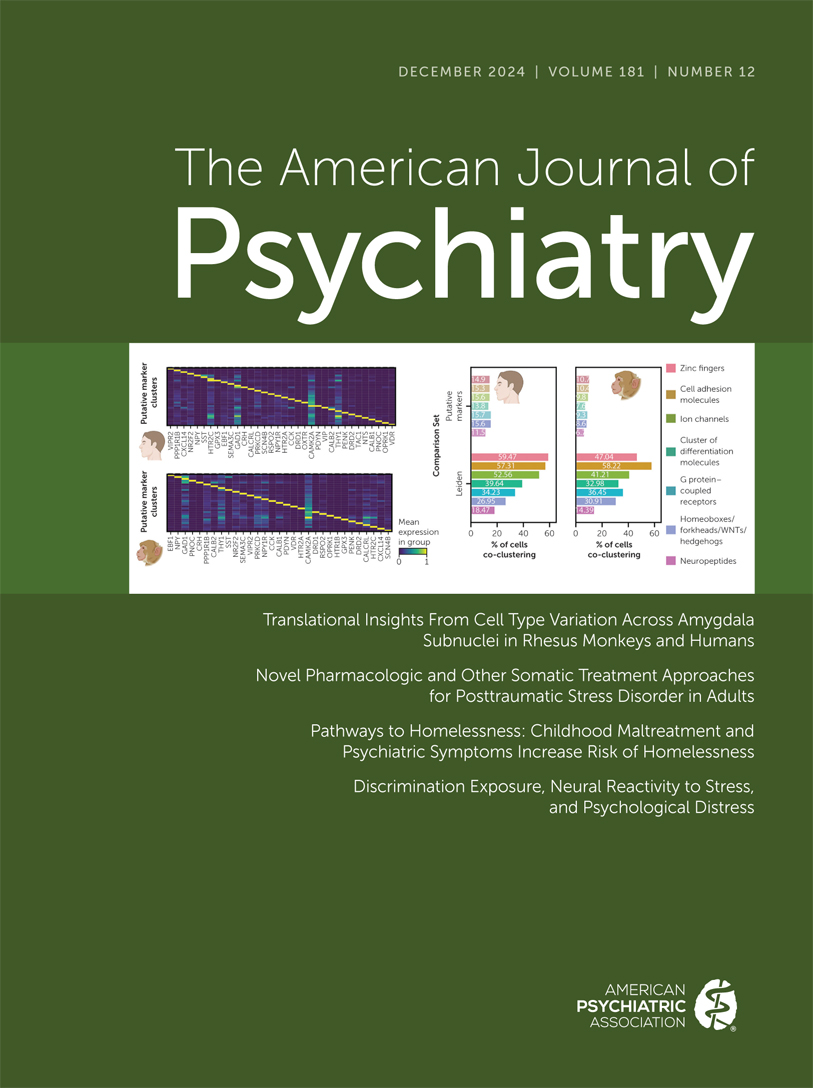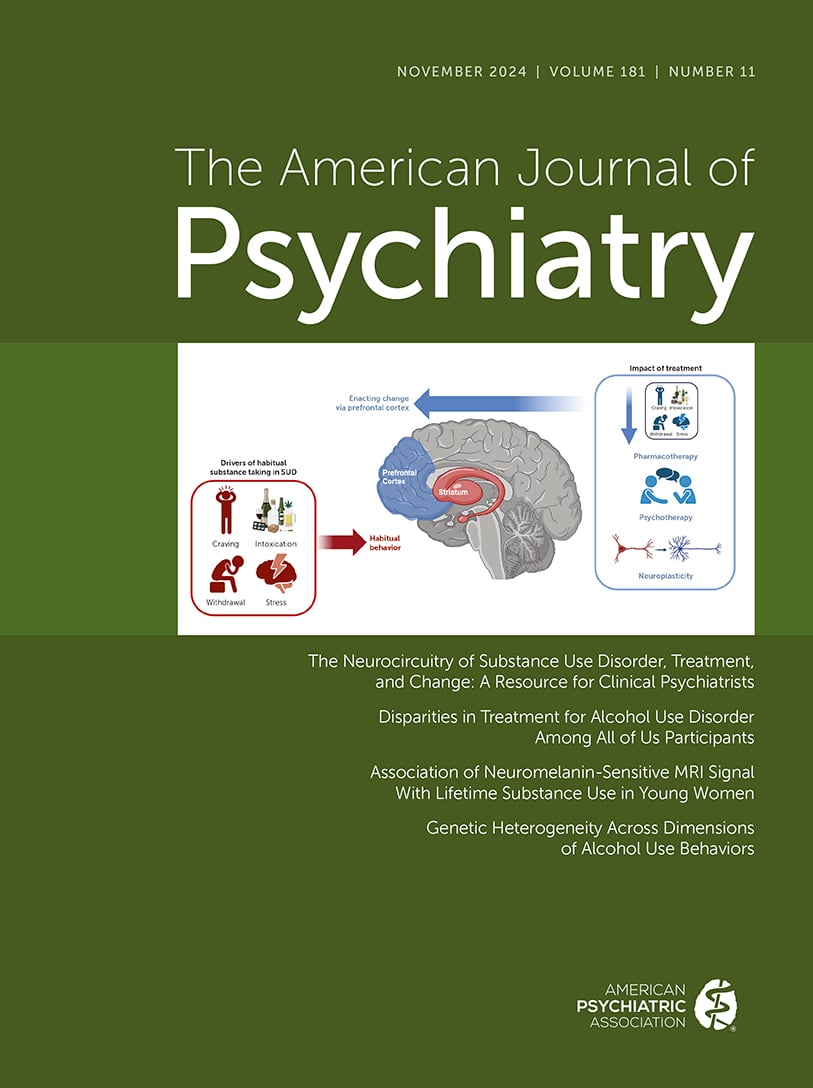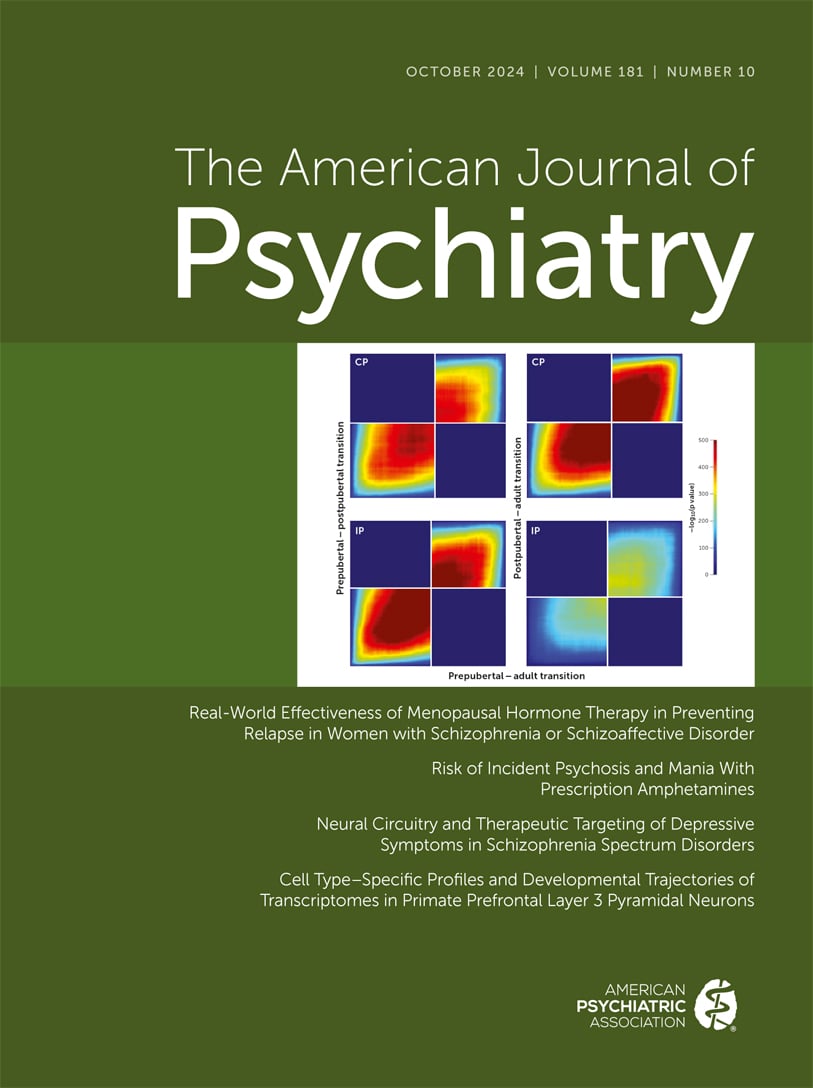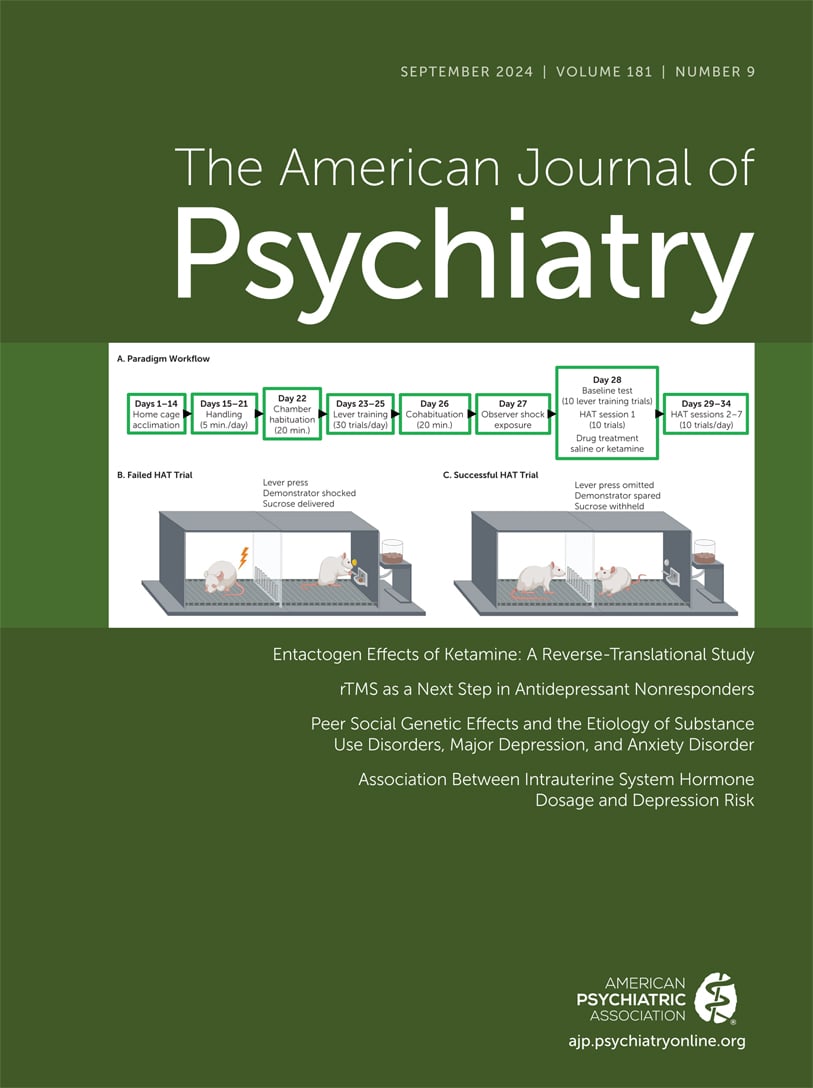American Journal of Psychiatry
- Volume 162
- Number 11
- November 2005
In This Issue
Editorial
Reviews and Overviews
Publication date: 01 November 2005
Pages1996–2021OBJECTIVE: The authors systematically reviewed the literature on psychological approaches to treating the neuropsychiatric symptoms of dementia. METHOD: Reports of studies that examined effects of any therapy derived from a psychological approach that ...
https://doi.org/10.1176/appi.ajp.162.11.1996Publication date: 01 November 2005
Pages2022–2030OBJECTIVE: The authors reviewed studies published between 1990 and 2003 that reported the prevalence, incidence, and persistence of, as well as the risk factors associated with, psychosis of Alzheimer’s disease. METHOD: PubMed and PsycINFO databases were ...
https://doi.org/10.1176/appi.ajp.162.11.2022Introspections
Clinical Case Conference
Images in Psychiatry
Presidential Paper
Article
Publication date: 01 November 2005
Pages2049–2060OBJECTIVE: The purpose of the study was to develop a strategy for functional imaging of neurodegenerative disorders that overcomes confounds associated with differential performance between patient and comparison groups. METHOD: Functional magnetic ...
https://doi.org/10.1176/appi.ajp.162.11.2049Publication date: 01 November 2005
Pages2061–2070OBJECTIVE: Age-associated cholinergic dysfunction may contribute to the cognitive decline observed during aging, including a decline in working memory. The current study was designed to determine how healthy aging influences the neural response to working ...
https://doi.org/10.1176/appi.ajp.162.11.2061Publication date: 01 November 2005
Pages2071–2077OBJECTIVE: “Mild cognitive impairment” refers to cognitive deficits in older age that exceed age-related cognitive decline but do not fulfill criteria for dementia. Affected subjects are assumed to be at higher risk for the development of dementia, such ...
https://doi.org/10.1176/appi.ajp.162.11.2071Publication date: 01 November 2005
Pages2078–2085OBJECTIVE: Subcortical ischemic vascular lesions, which are closely related to small vessel disease, are a common substrate of cognitive impairment and dementia. Cerebral autosomal dominant arteriopathy with subcortical infarcts and leukoencephalopathy (...
https://doi.org/10.1176/appi.ajp.162.11.2078Publication date: 01 November 2005
Pages2086–2093OBJECTIVE: This study examined the frequency of major and minor depression in Alzheimer’s disease and determined whether these types of depression have a different functional and psychopathological impact and whether there is a change in the prevalence of ...
https://doi.org/10.1176/appi.ajp.162.11.2086Publication date: 01 November 2005
Pages2094–2100OBJECTIVE: The right to vote can be abrogated when persons become incompetent to cast a ballot. This applies particularly to people with Alzheimer’s disease, who at some point will lose capacity. A 2001 federal court decision offered the first clear ...
https://doi.org/10.1176/appi.ajp.162.11.2094Publication date: 01 November 2005
Pages2101–2108OBJECTIVE: The authors previously reported an association between the D-amino acid oxidase activator (DAOA)/G30 locus and both schizophrenia and bipolar affective disorder. Given the presumed role of DAOA/G30 in the neurochemistry of psychosis and its ...
https://doi.org/10.1176/appi.ajp.162.11.2101Publication date: 01 November 2005
Pages2109–2115OBJECTIVE: Converging evidence implicates prefrontal circuits in the pathophysiology of bipolar disorder. Proton spectroscopy studies performed in adult bipolar patients assessing prefrontal regions have suggested decreased levels of N-acetylaspartate (...
https://doi.org/10.1176/appi.ajp.162.11.2109Publication date: 01 November 2005
Pages2116–2124OBJECTIVE: Major depression is a major risk factor for suicide. However, not all individuals with major depression commit suicide. Impulsive and aggressive behaviors have been proposed as risk factors for suicide, but it remains unclear whether their ...
https://doi.org/10.1176/appi.ajp.162.11.2116Publication date: 01 November 2005
Pages2125–2130OBJECTIVE: Depression is a potential risk factor for morbidity and mortality among patients with numerous medical conditions, including HIV disease, and it is also associated with decrements in immune function, such as natural killer (NK) cell activity. ...
https://doi.org/10.1176/appi.ajp.162.11.2125Publication date: 01 November 2005
Pages2131–2138OBJECTIVE: This study assessed the efficacy of 1) matching patients to treatments and 2) adding additional family therapy or cognitive therapy in a group of recently discharged patients with major depression. METHOD: Patients with major depression were ...
https://doi.org/10.1176/appi.ajp.162.11.2131Publication date: 01 November 2005
Pages2139–2145OBJECTIVE: Depressive symptoms are associated with an increased risk of cardiac events in patients with heart disease. Elevated catecholamine levels may contribute to this association, but whether depressive symptoms are associated with catecholamine ...
https://doi.org/10.1176/appi.ajp.162.11.2139Publication date: 01 November 2005
Pages2146–2151OBJECTIVE: This study estimated the proportion of patients attending an urban general medical practice with current major depression and a history of bipolar disorder and compared the history, presentation, and treatment of patients with unipolar and ...
https://doi.org/10.1176/appi.ajp.162.11.2146Publication date: 01 November 2005
Pages2152–2161OBJECTIVE: The authors tested the hypothesis that divalproex would be more effective than lithium in the long-term management of patients with recently stabilized rapid-cycling bipolar disorder. METHOD: A 20-month, double-blind, parallel-group comparison ...
https://doi.org/10.1176/appi.ajp.162.11.2152Publication date: 01 November 2005
Pages2162–2170OBJECTIVE: Lithium has been used during pregnancy for more than four decades, but quantification of fetal lithium exposure and clinical correlations of such exposure are limited. The study objectives were to 1) quantify the rate of lithium placental ...
https://doi.org/10.1176/appi.ajp.162.11.2162Brief Report
Publication date: 01 November 2005
Pages2171–2173OBJECTIVE: Neuropsychological studies of major depressive disorder have described attentional biases for affectively laden stimuli, but these reports were based on measures obtained from medicated subjects. This study investigated performance of ...
https://doi.org/10.1176/appi.ajp.162.11.2171Publication date: 01 November 2005
Pages2173–2175OBJECTIVE: The authors’ goal was to examine the incidence and predictors of emergent suicidality that occurred during a clinical trial of psychotherapy for adolescent depression. METHOD: The rates and predictors of emergent suicidality in 88 medication-...
https://doi.org/10.1176/appi.ajp.162.11.2173Publication date: 01 November 2005
Pages2175–2177OBJECTIVE: The authors used confirmatory factor analysis to replicate earlier findings that complicated grief, depression, and anxiety are distinct syndromes. METHOD: Data were derived from 1,321 bereaved individuals. Complicated grief was measured with ...
https://doi.org/10.1176/appi.ajp.162.11.2175Publication date: 01 November 2005
Pages2178–2180OBJECTIVE: This report examined suicidal behavior during bereavement. METHOD: Suicidal ideation was examined in a group of 60 recently bereaved widows and widowers compared to 60 individually matched married comparison subjects. RESULTS: Suicidal ideation ...
https://doi.org/10.1176/appi.ajp.162.11.2178Publication date: 01 November 2005
Pages2180–2182OBJECTIVE: The authors’ goal was to evaluate whether suicide attempters’ reaction to surviving their attempt predicted eventual suicide. METHOD: Three hundred ninety-three suicide attempters were categorized on the basis of their reaction to having ...
https://doi.org/10.1176/appi.ajp.162.11.2180Publication date: 01 November 2005
Pages2182–2184OBJECTIVE: Autism is a neurodevelopmental disorder with childhood onset and a known major genetic component. A recent study identified a highly significant association between autism and a two-single-nucleotide-polymorphism haplotype in the SLC25A12 gene, ...
https://doi.org/10.1176/appi.ajp.162.11.2182Publication date: 01 November 2005
Pages2184–2188OBJECTIVE: The authors’ goal was to examine the prevalence of impulse control disorders in psychiatric inpatients. METHOD: They used the Minnesota Impulsive Disorders Interview, a semistructured clinical interview assessing pathological gambling, ...
https://doi.org/10.1176/appi.ajp.162.11.2184Publication date: 01 November 2005
Pages2188–2190OBJECTIVE: Despite evidence of potential psychiatric sequelae following peacekeeping operations, no data have appeared on treatment outcome for this population. This study examined intake and treatment outcome data for a group of peacekeepers with ...
https://doi.org/10.1176/appi.ajp.162.11.2188Letter to the Editor
Book Forum: GENETICS AND NEUROSCIENCE
Book Forum: PROFESSIONAL ISSUES IN PSYCHOLOGY
Book Forum: LAW AND ETHICS
Book Forum: SCHIZOPHRENIA
Correction
Official Actions
Past Issues
View Issues Archive
Vol. 181 | No. 12

Vol. 181 | No. 11

Vol. 181 | No. 10
